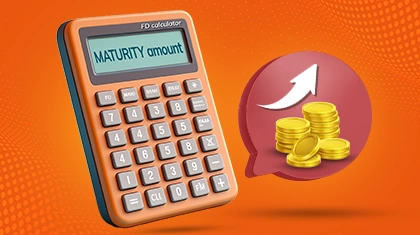THE
ORANGE
HUB
What is a Tax Saving Fixed Deposit for Section 80C Deductions

Tax Saving Fixed Deposits (FD) are special saving schemes that help individuals save on taxes while earning interest. Under Section 80C of the Income Tax Act, 1961, investors can claim a tax deduction of up to ₹ 1.5 lakh per year by investing in these FDs. However, Tax Saving FDs come with a lock-in period of 5 years, meaning you can't withdraw the invested amount during this time. The interest rate for tax saving FDs varies from bank to bank and the interest earned on this is considered as taxable income.
How Does A Fixed Deposit Work?
You need to deposit a lump sum amount for a fixed tenure that suits your requirement. Your investment gets a locked-in interest rate and the same is applied, irrespective of any interest rate fluctuations in the future.
Fixed Deposits are not exposed to market volatility and are considered safe. You can also choose to renew your Fixed Deposit in case of non-withdrawal at the time of maturity.
Fixed Deposits are preferred over regular Savings Account as they offer higher returns on your principal. What’s more? There are special Fixed Deposit schemes for senior citizens offered by banks and Non-Banking Financial Companies (NBFCs), wherein higher interest rates are provided, over and above the existing ones.
Some key features of a Tax Saving FD are:
A Tax Saving FD lets you avail Income Tax exemption under Section 80C of the Income Tax Act, 1961. The Fixed Deposit Income Tax exemption can be claimed on investments of up to ₹ 1.5 lakh
The lock-in period is five years
The interest earned, as a part of the Tax Saving Fixed Deposit is taxable and is deducted at source
Premature withdrawals, Loans or Overdraft (OD) facilities are not available for a Tax Saving FD. Regular Fixed Deposits offer Loan against deposits
There is no auto-renewal facility for Tax Saving Fixed Deposits
Interest payouts are flexible; you can opt for monthly or quarterly payouts or reinvest in principal
Tax Saving FD interest rates remain unchanged over the five-year period
Interest rates differ from bank to bank and rates for Indian citizens, Hindu Undivided Family (HUF) also vary
Tax Saving FDs can be held in a single or a joint mode. If it’s a joint Tax Saving Fixed Deposit, tax benefits are available only to the first account holder.
Advantages of Tax Saving Fixed Deposits compared to other Section 80C investments
The two most common options for claiming income tax exemption under Section 80C include Equity Linked Savings Scheme (ELSS) and Public Provident Fund (PPF). The main advantage that a Tax Saving FD has over ELSS is that it is not market-linked. While ELSS has a lower lock-in period of three years, the minimum investment required is ₹ 500. Also, ELSS comes with some amount of risk as it is market-linked. The minimum investment required in a Tax Saving Fixed Deposit is ₹ 10,000. While you can open a PPF Account with an opening balance of ₹ 500, the minimum investment has to be ₹ 500. Also, a PPF comes with a lock-in period of 15 years.
Who should invest in a Tax Saving FD?
Before selecting any investment option, you need to consider your age, risk appetite and investment horizon.
You are nearing retirement and have a low-to-zero risk appetite: A Tax Saving FD is a good choice for you, as it provides dual benefits of guaranteed returns and low risk. You can compare the Tax Saving FD interest rates and choose the one that fits your investment requirements.
You need to save taxes: You can claim a Tax exemption under Section 80C to save taxes.
How much should you invest under the Tax Saving FD scheme? What will be the maturity amount?
Now that you know all about the Tax Saver FDs and tax saving FD interest rates, it’s time to calculate the interest rate (annualised) on your investment. That’s where a Tax Saving FD Calculator comes handy. It also helps you arrive at an estimate of how much you need to invest. A Tax Saving FD Calculator is available online and is offered by banks for the benefit of their customers. You can use it to compare different interest rates and pick one that offers the best guaranteed returns. Calculating the maturity amount of your FD manually can be time consuming and complex. When using a Tax Saving FD Calculator, simply input details such as the principal amount, rate of interest (annual) and tenure, to get your answer.
Conclusion
If you are looking at an investment option that fulfils the criteria of guaranteed returns, zero risk and growth, you should pick a Fixed Deposit. A Tax Saving FD is one step better - it is aimed at helping you claim a Fixed Deposit income tax exemption under Section 80C of the Income Tax Act for investments up to ₹ 1.5 lakh. A Tax Saving Fixed Deposit comes with a five year lock-in period and a minimal investment requirement of ₹ 10,000. You can look up interest rates for a Tax Saving FD scheme and invest your wealth in a safe and secure manner.
T&C
For disclaimer, Click Here
Scroll to top











